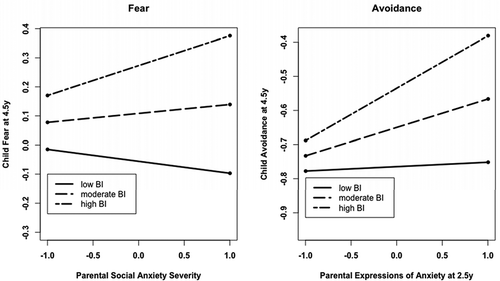Figures & data
TABLE 1 Sociodemographic Characteristics of the Sample
FIGURE 1 Time flow of the current study. Mothers and fathers of each participating child joined the lab visit at each measurement point. At 2.5 and 4.5 years measurement, there was also a home visit. SR = Social referencing; BI = behavioral inhibition.

TABLE 2 Descriptive Statistics for the Outcomes and Predictors in Multilevel Regressions
TABLE 3 Raw Correlations Between the Outcomes and Predictors in Multilevel Regressions
TABLE 4 Multilevel Regressions of Child Fear and Avoidance at 4.5 Years on Parental Expressions of Anxiety at 1, 2.5, and 4.5 Years
FIGURE 2 Plot of the interaction between parental social anxiety severity and behavioral inhibition (BI) in toddlerhood in the fear model (on the left), and between parental expressions of anxiety at 2.5 years (y) and child BI in the avoidance model (on the right). Moderate, low, and high levels of infant BI were set to mean, 1 SD below the mean, and 1 SD above the mean, respectively. More severe forms of parental social anxiety were related to more fear only in high BI children (z > 1.05). More expressed anxiety at 2.5 years from parents predicted more avoidance in moderate-to-high BI children (z > .07).

TABLE 5 Multilevel Regressions of Change in Child Fear and Avoidance from Infancy to Childhood on Parental Expressions of Anxiety at 1 Year and Child Behavioral Inhibition at 1 Year
